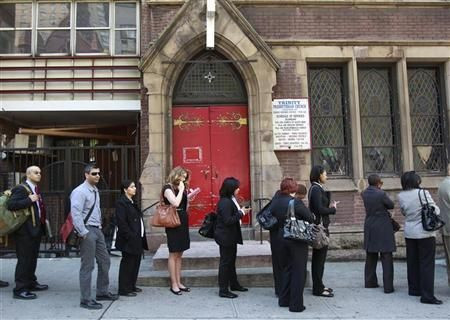
Employment grew faster than expected in November as the hit from superstorm Sandy on payrolls was less forceful than many feared.
At the same time, the jobless rate fell to a near four-year low, but that was largely because so many Americans gave up the hunt for work.
Nonfarm employment increased by 146,000 jobs last month, the Labor Department said on Friday, defying expectations of a sharp pull back related to superstorm Sandy.
The government said the storm which slammed the densely populated East Coast had not had a substantive impact on last month's employment and unemployment estimates.
U.S. financial markets appeared to put more faith in the payroll growth figures, with stock indexfutures turning positive and prices for U.S. government debt falling.
"The labor market is not getting worse, but is also not getting much better as it is unchanged relative to the recent trend," said Jacob Oubina, a senior U.S. economist at RBC Capital Markets in New York.
The 0.2 percentage point drop in the unemployment rate to 7.7 percent -- the lowest since December 2008 -- represented a drop in both the labor force and employment as measured by a survey of households. Economists generally rely more heavily on the payrolls reading from the separate and much larger survey of employers.
While job gains for both September and October were revised to show 49,000 fewer jobs created than earlier reported, the revision was concentrated in the government sector.
Job gains have averaged 151,000 per month this year, just enough to push the jobless rate lower, but only slowly. Economists say roughly 200,000-250,000 jobs per month are needed to really make headway.
Employment continues to be held back by fears the government may fail to prevent the $600 billion in automatic tax hikes and government spending cuts set to take hold at the start of next year. The debt crisis in Europe has also weighed.
With the pace of job growth still too slow, November's report is not expected to have much impact on Federal Reserve policymakers, who meet next Tuesday and Wednesday.
Economists said an anticipated tightening of fiscal policy next year, even if a deal is reached to avoid completely going over the "fiscal cliff," provides ample reason for the U.S. central bank to maintain its ultra-easy monetary policy stance.
"It doesn't change the outlook for the Fed ... I still would be expecting them to announce next week that they'll be extending their purchases to next year," said Jeremy Lawson, a senior U.S. economist at BNP Paribas in New York.
Relentless labor market weakness led the Fed in September to launch a program to buy $40 billion worth of mortgage-backed securities every month to drive down borrowing costs.
That is on top of a program dubbed "Operation Twist" in which it was re-weighting securities it holds toward longer maturities. Twist expires at the end of this month and economists expect the Fed to replace it with a program that buys government bonds with newly created money.
All of the meager jobs gains in November were in the private sector, with government employment slipping 1,000.
Within the vast private services sector, retail employment gained 52,600, professional and businesses services increased 43,000. Temporary help hiring increased 18,000.
In the goods-producing sector, manufacturing employment fell 7,000. Construction payrolls surprisingly dropped 20,000, despite a surge on homebuilding, which is benefiting from the Fed's accommodative policy stance.
Average hourly earnings increased four cents. In the 12 months to November, average hourly earnings rose 1.7 percent.
The length of the average workweek held steady at 34.4 hours in November.
© Thomson Reuters.




